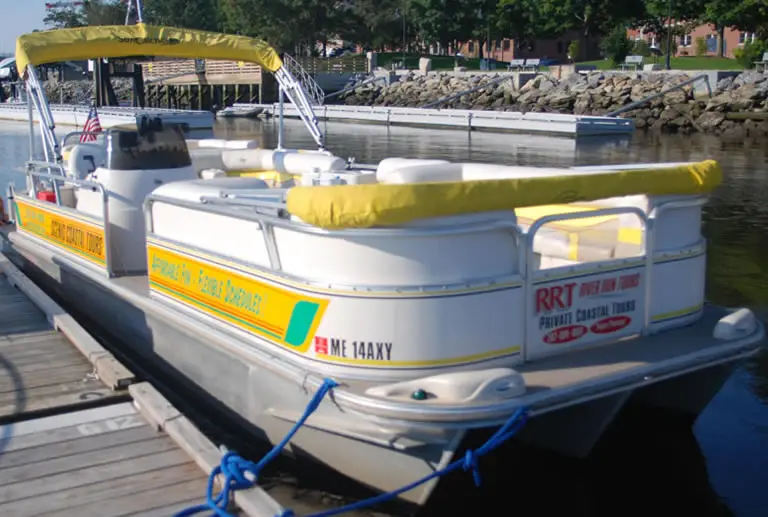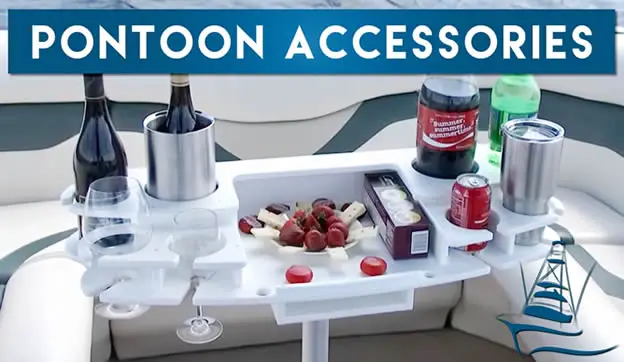Pontoon boats are easy to handle and drive when out on the water but docking the boat is a different matter. Docking a pontoon boat can take a bit of practice, but but before you even start the docking procedure you have to know where to park the boat. This means you need to know a little about pontoon boat docks.
There are 4 common areas to dock a pontoon boat: a stationary dock, a portable dock, a floating dock or on a boat lift. Alternatively, you can anchor a pontoon boat anywhere on the water, as long as you are not obstructing other water users.
Obviously, you will need the appropriate type of anchor for the water bottom you are anchoring in if you intend to park the boat away from a pontoon boat dock.
However, when docking at a specified pontoon boat dock all you need are mooring lines, which are attached to cleats or poles on the dock to stop your boat from floating away.
Contents
The science of the pontoon dock & pontoon docking
Pontoon boats are a lot of fun out on the water. There are endless activities you can engage in on a pontoon boat that go far beyond just partying (though that is fun too).
Likewise, there are lots of different places a pontoon boat can be used from shallow water to deep lakes. But what happens when the fun is over and it’s time to go home.
Where do you park your boat?
The 4 types of pontoon boat dock & how they work
Most pontoon boats will be docked in a marina or private docking area. Areas assigned for docking pontoon boats can have different types docks. There are four basic dock types suitable for pontoon boats.
They are:
- Stationary docks.
- Floating docks.
- Portable docks.
- Boat lifts.
Let’s take a look at these different dock types now.
Stationary pontoon docks
A stationary dock is a permanent docking area that is fixed in place.
A stationary dock may be a typical-looking dock that is supported by poles or posts. These docks are the best choice for protecting your boat as they are a secure area should wind or waves pick up.
The problem with these docks occur when tides, or dams, effect the water depth and the boat must have longer dock lines thus leaving it open to banging against the dock. If the dock lines are too short the boat cannot properly move up and down with the water – like this one.
Floating pontoon docks
Floating docks are used in areas, such as deep water bays or along shorelines, where the water depth fluctuates.
A floating pontoon dock is also permanent structure that is fixed in place. However, unlike a stationary dock, which remains at the same height, a floating pontoon dock moves up and down with changes in water depth as the tide ebbs and flows.
Portable boat docks
A portable dock, sometimes called a wheeled dock, is removed from the water during the off-season months when most pontoon boats are permanently stored on land.
Many of these types of dock are used in areas that experience ice on the water. Where water turns to solid ice in the winter months a portable dock is preferable as the ice could easily damage a stationary dock.
Portable docks are fitted with wheels and therefore the ground they are used on must be fairly even, and compacted enough to allow the dock to be wheeled on it.
Boat lifts
Boat lifts are a great way for docking a pontoon boat. We covered how pontoon boat lifts work here.
Basically a boat lift is very simply. It is used to lift the pontoon boat completely out of the water. This protects the boat from corrosion and possible mishaps that could occur with shifting water depth.
Most boat lifts are positioned at a stationary dock and are used as an additional safety measure for protecting the boat in the same way as a floating dock but with the added benefit of also protecting the pontoons from the build-up of algae, mussels and barnacles.
How to dock a pontoon boat
Once you know where you are going to dock your pontoon boat you now need to know how to dock it.
How to dock a pontoon boat safely & efficiently
There are 5 simple steps for docking a pontoon boat. They are:
Step 1. Put the pontoon boat into neutral and allow the boat to coast towards the dock.
Step 2. Continue to coast towards the dock slowly and be prepared to trim the motor if you are entering shallower water. Do not lift the prop completely out of the water as you will need it later.
Step 3. As you near the dock put the boat in reverse to slow it down. Keep reversing until you are approximately 20 feet from the dock. Then put the boat back into neutral.
Step 4. Once you are closer to the dock and are happy with your positioning re-engage the reverse gear to slow the boat down further and to bring it to a stop.
Step 5. Use a a dock stick with a hook on it to grab hold of the pilling to pull your boat tight into the dock.
You can see how a dock stick is used in the video below.
The pontoon boat in the video is being docked in reverse and much faster than normal simply to demonstrate the effectiveness of the dock stick. You should dock forward and much slower.
How to dock a pontoon boat demonstration (video)
Pontoon docking tips
Below are a few docking tips to help you park your pontoon boat safely regardless of which particular dock you choose to use.
Use fenders
You are on a very expensive boat. Treat it like one.
Fenders are essential bits of kit that will protect your hull from damage. Good fenders are one of those essential pontoon boat accessories that allow you a lot of leeway when docking, especially when you are new to it. Many boaters new to pontoon boats tend to take the docking procedure a little too fast.
A pontoon boat is not like other boat and will glide towards the dock like a hockey puck on ice. Fenders will help take the impact should you hit the side of the dock hard.
Even if you park perfectly, you will need fenders to protect the side of the boat as the water jostles it against the dock.
Slow it all down
If you think you are going too slow … slow down some more!
Until you get used to the docking procedure take it ultra slow.
When you move your boat slowly you have much more time to react to unforeseen events and more time to adjust your boat’s course if you need to.
Don’t be afraid to use your motor to slow you down. If you find that you have engaged reverse for too long and the boat stops, it’s not a problem. Just re-engage drive and start moving forward again.
Once the boat is moving knock the motor back into neutral, while being ever-at-the-ready to re-engage reverse gear.
Attach the dock ropes to the dock cleats
You do not anchor a pontoon boat at a dock.
You tie it to cleats or poles available on the dock, via dock ropes or mooring lines.
Where to anchor a pontoon boat when there is no dock
Anchoring a pontoon boat is different from docking it. Docking your boat is a done near the shoreline, or in a marina, and requires a dock. When it comes to setting the anchor, you can pretty much anchor your pontoon boat just about anywhere you want to out on the water.
Where can you anchor a pontoon boat when there is no pontoon boat dock available?
You can anchor a pontoon boat anywhere on the water as long as you are not impeding other boats or water users.
Obviously anchoring in the middle of a busy passageway or at the corner of a bend would be unwise. But, as long as other water users can pass by you without difficulty you are safe to anchor your pontoon boat.
Remeber: you do not anchor a pontoon boat at a dock. You tie it to cleats or poles via dock ropes.
There are different anchor types and different anchoring techniques used in different types of marine environments.
For example, a power-pole anchor set-up can be used to keep your boat in position in very shallow waters while a much stronger anchor, with adequate line, is required for deeper waters.
The best pontoon boat anchor for one situation may not be the best for another.
In fact, one anchor that is perfect for one type of bottom may be totally useless in another. We covered pontoon boat anchor types here and you should read that article before choosing an anchor for your pontoon boat.
If you need a walk-through of the process of anchoring a pontoon boat be sure to read this article.
You should also be aware of the dangers involved in anchoring and using a pontoon boat in rough water.



